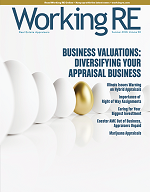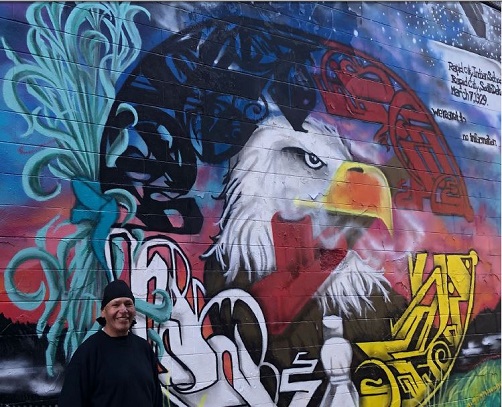 |
“One of the best courses that I have had in 17 years!” -Amy H.
|
Street Art Is Real Estate: What Appraisers Need to Know
by Michele Wood, Valbridge Property Advisors
Art is real estate—what? Yes indeed—read on.
There was a time when images spray-painted onto the walls of buildings was a sign of blight and urban decay. These days, many cities are joining a growing movement of not only allowing graffiti to exist, but even fostering its development as “street art.” How does street art affect the real estate on which it is placed, and does it affect the real estate market around it? What distinguishes street art from graffiti? How are the interests of property owners, artists, and the community balanced by relevant laws? We will touch on all of those topics in this article.
Graffiti is as old as civilization itself. The term comes from the Italian “graffiare,” which means “to scratch.” Graffiti generally is understood to be simple words or a name, sometimes in stylized form, but never pictorial. Street art, on the other hand, includes visual elements such as characters, landscapes, portraits, poems and other written word forms in order to express the artist’s intent.
Public street art can be seen in almost any community nowadays, and it is no longer a phenomenon of larger coastal cities like New York or Los Angeles. Street art has gained wider acceptance as a desirable visual element in communities and acts, as all public art does, to serve three functions: 1) to beautify the public space, 2) to create and foster an environment of social cohesion, and 3) to encourage economic stabilization. Communities are paying attention. A Google search for “Street Art Blog” results in 830,000,000 links. Similarly, a search for “Street Art Tour” brings up countless links in most cities that are included in the search terms.
Can the presence of street art affect real estate pricing? The evidence is starting to suggest that it does, and in a positive way. Researchers at the University of Warwick in England set out to quantify the link between street art and value. Their thesis, that areas of higher concentrations of street art would see a correlative uptick in real estate values, was predicated on the premise that creative industries are key to building a successful city economy. The scientists looked at images of London uploaded to the social media site Flickr between 2004 and 2013 in which the word “art” was tagged. They then used that data to compare the number of art images in a neighborhood to changes in residential real estate prices in that neighborhood. They found that increases in mean residential property prices are significantly associated with higher proportions of art images per neighborhood.
A follow-up survey done in 2017 by the Affordable Art Fair revealed that 43% of British citizens would rather live in an area with murals and street art than a local coffee shop, and would be willing to pay an average of £8,549 more for a home in an area with street art. Thirty two percent of those surveyed reported that they would spend as much as £50,000 more.
These results have been borne out anecdotally in many other places. In Miami, for example, visitors from all over the world flock to the Wynwood area to see the “Wynwood Walls,” a series of murals painted on the exterior walls of old warehouses. The project started in 2009 with 18 large works and has since grown to cover 800,000 SF featuring 50 artists. The project was so successful that rents began to increase substantially. For instance, a warehouse that leased in the early 2000s for under $10 per square foot now rents for an average of $50 per square foot. Galleries, restaurants and retail shops have all moved in to capture the foot traffic, increasing demand for all kinds of real estate.
(story continues)
Multi-family projects are taking note of the street art benefit as well. Developer Crescent Communities has started to incorporate street art into their new apartment properties. The marketing director has noted that people will drive or walk over to see the art and end up touring the property as potential residents. Renters almost always request units with views of the art. Muralists all over the United States are starting to get requests from landlords looking to have their buildings painted as they think it will attract tenants and discourage “unsanctioned” graffiti since there is a mutual respect among artists wherein they don’t deface others’ works.
The Rice Mill Lofts in the Bywater neighborhood of New Orleans also found a way to incorporate street art into its design. Originally built in 1892 as a rice mill, the building was renovated to loft apartments in 2010. Because the building had sat vacant for several decades, there were numerous walls with graffiti. The developer decided to incorporate the art into the new units, preserving as much of it as possible in the renovation and hiring local artists to add more. This aspect is featured on the property’s website saying, “The improvisational riff of text and images tells both tales of caustic discontent, as well as stories of sacred archetypes, heroes and mythmakers.” The 69-unit project reached full occupancy in five months, and the units with the most distinctive graffiti pieces have a wait list. Within two years of the renovation, the property was the highest rent per-unit residential building in New Orleans.

In 2012, well-known muralist Eduardo Kobra painted murals on a building in New York City. Between the time that the murals were done and the sale of the building four years later, the price increased from $880,000 to over $2,000,000. Though it was difficult to break out the murals’ contribution, a local real estate agent attributed 10 to 15% of that value growth to the murals. If one is lucky enough to own a building on which the notorious street artist Banksy paints, the property value could double overnight.

The Wall is the Painting
The addition of street art to buildings is not without its complications, however. As works of original visual art, many pieces are protected by a federal law called the Visual Artists Rights Act of 1990, or “VARA.” VARA seeks to protect an artist’s moral rights in addition to the economic rights conferred by copyright law. This means that an original work cannot be destroyed, distorted, mutilated, or modified in any way that “would be prejudicial to his or her honor or reputation.” VARA is similar to copyright, but applies only to works of visual art. Unlike copyrights, VARA rights cannot be transferred from the artist to anyone else, and expire on the artist’s death.
(story continues)
With private ownership of a framed painting hanging on a wall, VARA presents few conflicts. However, with street art, the wall is the painting, so ownership and control of that wall can become problematic between the property owner’s rights and the artist’s VARA rights. Some important features of how VARA affects real property include:
- Artwork is covered under VARA if it is of “recognized stature” only. To determine if a work qualifies, the artist must prove that the work is viewed as meritorious and that this is recognized by art experts, other members of the artistic community, or by some cross-section of society. This sets a rather low bar to determine that a work is of recognized stature as there are many ways to convince a court that a cross-section of society deems the work as having merit.
- The property owner cannot destroy or alter the work in any way. This includes scrubbing it off, painting over it, or carving a drive-through window out of it. The property owner does, however, have the right to sell the artwork. Numerous people have carved Banksy stencil art off of the walls on which they were painted and sold them for substantial sums. VARA only protects the integrity of the art, not the physical location of the work or the ownership of it.
- If the property owner wishes to demolish a building on which artwork of recognized stature exists, the owner must make a documented good-faith attempt to notify the artist before destruction and grant 90 days from contact for the artist to remove or document the work (at the artist’s cost).
- The property owner does not own the copyright of the image unless the artist has transferred the copyright in writing. Using an image of the artwork in merchandise or productions would be prohibited unless permission is granted by the artist. Appraisers could photograph the work for use in a report, but any commercial uses of the image would be prohibited. Copyright is distinct from VARA protections.
- VARA does not apply to works that advertise or promote a product or service, and works that are illegally done (i.e., without the property owner’s permission) are likely not protected by VARA, though case law is not entirely clear on this point in all instances. If a work has been in place for a long time and is of recognized stature in the community, it may be protected by VARA and copyright, even if illegal. If the illegal work can be moved without destroying it, VARA rights will probably apply.
- VARA does not protect works against obfuscation. If a property owner wants to obscure the view of the work by adding a wall or covering the work in a way that would not damage it, it would not be illegal. However, owners have faced tremendous public outcry when they have obscured access to popular artwork.
- New York and California grant even stricter moral rights to artists, so property owners in those states need to be aware of the restrictions that apply to their sites. In New York, the law is called the Artists Authorship Rights Act (1984) and in California it is known as the California Art Preservation Act (1979).
- Because VARA allows artists to waive their VARA rights, property owners are best protected against VARA claims by securing a waiver before commissioning a work or before buying a property that has street art incorporated. This could have special relevancy to title companies.
In general, property owners of original street art can enjoy great collaborative relationships with the artists, even when their needs require a modification or change to the existing art. Most artists recognize the place of their work in the larger built environment landscape, and street artists especially are comfortable with the ephemeral nature of their art. Conflicts tend to arise when a property owner acts with disregard or disrespect to the artist, the artwork, or the community. Such a case recently made headlines in New York when a developer painted over dozens of well-loved murals on a site that had been known as 5Pointz.
5Pointz was the name given to a site of vacant and run down industrial buildings in Queens. Developer Jerry Wolkoff purchased the site in the 70s to hold as an investment for future development. In 1993, Wolkoff gave an artist, Jonathan Cohen, access and verbal permission to paint on the buildings and “curate” the artwork that was done on the walls. The site gained notoriety as a premier location for aerosol artists, and people started to come from all over the country to see it. In 2013, Wolkoff decided to go ahead with redevelopment of the property into new residential towers. The artists, though they knew Wolkoff had always intended redevelopment, tried in vain to prevent the razing of the structures. In November of 2013, a judge denied injunction to the artists and Wolkoff, overnight, had the buildings whitewashed.
A group of artists from 5Pointz, including Cohen, filed a claim under VARA and in February 2018, the developer was ordered to pay $6.75 million in statutory damages to those artists. Notable details from that case include Wolkoff’s “willful” destruction of the works, his hostile attitude toward the artists and the judge during the hearings, and his failure to grant the artists the requisite 90 days to remove or document the works. The takeaway seems to be that respect and collaboration result in the most lucrative relationships for both parties.
Developers, property owners and appraisers need to be aware of street art works, VARA, and how it can potentially impact the value of residential and commercial real estate. It cannot simply be excluded as personal property from the valuation any more than tenant improvements can be. As it becomes more prevalent and more sought after as an amenity, real estate professionals will need to be versed in the nuances of VARA and its applications. No longer a sign of urban decay, street art is now becoming a sign that a colorful neighborhood is the most vibrant part of a city, and making a meaningful, measurable contribution to real property value.
About the Author
Michele Wood is Director of Business Development for the Right-of-Way and Litigation Services practice groups with Valbridge Property Advisors | Houston. She also heads up research and special projects for the firm. She has worked in commercial valuation for 15 years.
CE Online – 7 Hours (AQB Approved)
Identifying and Correcting Persistent Appraisal Failures
Richard Hagar, SRA, is an educator, author and owner of a busy appraisal office in the state of Washington. Hagar now offers his legendary adjustments course for CE credit in over
40 states through OREPEducation.org. The new 7-hour online CE course Identifying and Correcting Persistent Appraisal Failures shows appraisers how to avoid CU’s red flags, minimize callbacks, save time, and earn more! Learn how to improve the quality of your reports and build defensible reports! OREP insureds save on this approved coursework. Sign up today at
www.OREPEducation.org.
Sign Up Now! $119 (7 Hrs)
OREP
Insured’s Price: $99
>Opt-In to Working RE Newsletters
>Shop Appraiser Insurance
>Shop Real Estate Agent
Insurance
Send your story submission/idea to the Editor:
isaac@orep.org





by Michael Ford, AGA, SCGREA, GAA, RAA, Realtor®
The author failed in argument to convince that art is real estate. I have street art two blocks north of my home on my street. While it is better than graffiti and gang symbols or profanity, it is also two other things (1) A label that my neighborhood is Latino (primarily); and (2) that it is drawn on city property.
I LIKE street art-even ethnic or cultural street art. But it is not deserving of legal protections that usurp real property owner rights (VARA). Efforts to make it so will ultimately lead to a return to non-aesthetic Grafitti and filth, because what owner in their right mind will authorize street art on their property knowing it deprives them of some of their ownership rights?
Street art is paint. It is not real estate. It is talented decor nothing more. Like any decor, a property owner can and should be able to change it-unfettered.
Artists should continue to be allowed to draw/paint positive messages on public property that otherwise would be Grafitti prone. But having that free venue should NEVER result in diminishment of the proeprty ownerrs rights-including that of cities.
-